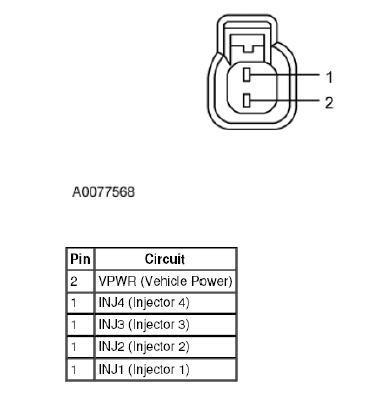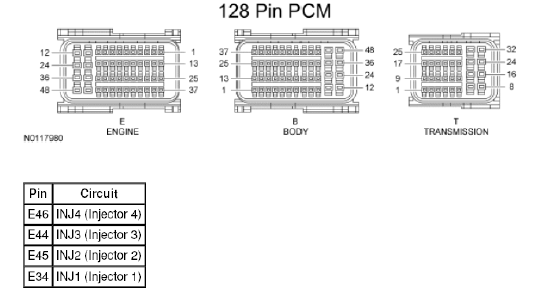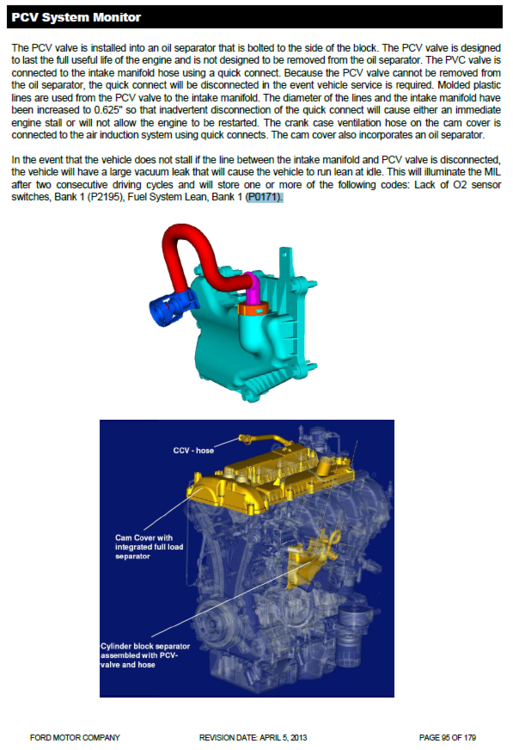-
Posts
124 -
Joined
-
Days Won
11
Content Type
Profiles
Forums
Gallery
Posts posted by Zathrus
-
-
Procedure to park front windshield wipers (in mid range) to facilitate blade change
-
-
I use Lucas fuel cleaner and it works great in cleaning CMAX fuel lines and injectors. I use 1/2 bottle per tank-full once every month or two: https://www.amazon.com/Lucas-Oil-LUC10020-Ounce-Treatment/dp/B0006305RY/ref=sr_1_2?crid=1BS63B59JNO1X&dchild=1&keywords=Lucas+Oil+LUC10020+Fuel+Treatment+-+5.25+Oz%2C+Multi-Colored&qid=1635463285&sprefix=lucas+oil+luc10020+fuel+treatment+-+5.25+oz%2C+multi-colored%2Caps%2C68&sr=8-2
There are also larger bottles available (I keep and re-fill the small bottle because the spout on that bottle works well in CMAX fuel inlet)
-
When my 2013 "grinding" transmission was replaced under warranty (at 47000 miles), the metal grinding noise was so loud that I had to increase radio volume 2-3 clicks when moving greater than 40 mph (and then back down again when stopped). This was with the windows up. Also, the grinding/thumping was cyclical, not continuous (frequency changed with speed).
The tech at my dealer test drove the car only 4 blocks before turning around and saying something was wrong. He used "chassis ears" to further isolate level and location of noise to the transmission. He also indicated that the chassis ears where also picking up abnormal noise from front wheel bearings, but level of wheel bearing noise was being drowned out by the noise from the transmission. To be safe, they decided to replaced front wheel bearings along with the transmission.
-
Just had my 12V battery replaced today (was 7.5 years old). Battery Monitor was reset, and the "BATTERY AGE" ForScan value changed from 2751 days to 0 days. Note that the "BATTAGEBECM" ForScan value (for the High Voltage Battery -HVB) remained 93 months (as the HVB was not affected).
So only the BATTERY AGE (corresponding to 12V battery age in days) will be reset. The BATTAGEBECM (corresponding to HVB age in months) will not be reset.
-
On 4/24/2021 at 12:06 PM, bugbearsdad said:
I changed the driver's side visor on my C-Max and now I am experiencing all kinds of electrical issues. The driver's side door locks and power windows are not working (I changed the fuse and that did not work), the front windshield wipers are stuck in the up position, and the interior lights are no longer working.
Check or charge your 12V battery. Others have posted when the 12V battery is low, the Body Control Module (BCM) acts up which can cause many of the electrical issues you are seeing.
-
Since the failure appears to be isolated to #4 (and is independent of injector or coil installed), perhaps there is an issue with the harness going from PCM (Power Control Module) to injectors.
The CMax Service manual for DTC P0201 calls for harness pinpoint testing as follows (cut & paste from service manual does not work well, so sorry for poor formatting below) :
DTC P0201: CYLINDER 1 INJECTOR A CIRCUIT/OPEN
DTC P0201: CYLINDER 1 INJECTOR A CIRCUIT/OPEN
Description: This DTC sets when the fuel injector circuitry is inoperative.
Possible Causes:
INJ1 circuit open
VPWR circuit open
Damaged fuel injector
Diagnostic Aids: The INJ1F PID is YES.
Application Key On Engine Off Key On Engine
Running
Continuous Memory
All GO to PINPOINT TEST KG .This pinpoint test is intended to diagnose the following:
fuel injector(s) (9F593)
harness circuits: VPWR and INJ 1 through 4
powertrain control module (PCM) (12A650)
Fig. 76: Identifying Fuel Injector Connector
Courtesy of FORD MOTOR CO.
 /
/
Fig. 77: Identifying Powertrain Control Module (PCM) Connector (128 Pin)
Courtesy of FORD MOTOR CO.TEST PROCEDURE
KG1 CHECK THE VPWR CIRCUIT FOR AN OPEN
NOTE: Disconnect the suspect fuel injector harness connector. Only the
suspect injector needs to be diagnosed.
Ignition OFF.
Fuel Injector connector disconnected.
Ignition ON, engine OFF.
Measure the voltage between:
(+) Suspect Injector Solenoid Connector, Harness Side (-)
VPWR Ground
Is the voltage greater than 10.5 V?
Yes No
GO to KG2 . REPAIR the open circuit. Clear the PCM DTCs. REPEAT the self-test.
KG2 CHECK THE INJ CIRCUIT FOR AN OPEN
Ignition OFF.
PCM connector disconnected.
Measure the resistance between:
(+) Suspect Injector Solenoid Connector, Harness
Side
(-) PCM Connector, Harness
Side
INJ INJ
Is the resistance less than 5 ohms?
Yes No
GO to KG3 . REPAIR the open circuit. Clear the PCM DTCs. REPEAT the self-test.
KG3 CHECK THE INJ CIRCUIT FOR A SHORT TO GROUND
/
Measure the resistance between:
(+) Suspect Injector Solenoid Connector, Harness Side (-)
INJ Ground
Is the resistance greater than 10K ohms?
Yes No
GO to KG4 . REPAIR the short circuit. Clear the PCM DTCs. REPEAT the self-test.
KG4 CHECK THE INJ CIRCUIT FOR A SHORT TO VOLTAGE
Ignition ON, engine OFF.
Measure the voltage between:
(+) Suspect Injector Solenoid Connector, Harness Side (-)
INJ Ground
Is any voltage present?
Yes No
REPAIR the short circuit. Clear the PCM DTCs. REPEAT the self-test. GO to KG5 .
KG5 CHECK THE RESISTANCE OF THE FUEL INJECTOR
Ignition OFF.
Measure the resistance between:
(+) Suspect Injector Solenoid Connector,
Component Side
(-) Suspect Injector Solenoid Connector,
Component Side
INJ VPWR
Is the resistance between 11 - 18 ohms?
Yes No
GO
to
KG6
.
INSTALL a new fuel injector. REFER to the appropriate Fuel Charging and Controls
article. RESET the keep alive memory (KAM). REFER to DIAGNOSTIC
MONITORING TEST RESULTS MODE 6 .
REPEAT the self-test.
KG6 CHECK THE FUNCTIONALITY OF THE INJ CIRCUIT
PCM connector connected.
Ignition ON, engine OFF.
Connect a non-powered test lamp between:
Point A Suspect Injector Solenoid
Connector, Harness Side
Point B Suspect Injector Solenoid
Connector, Harness Side
VPWR INJ
Is the test lamp blinking?
Yes No
GO to KG7 . GO to KG8.
KG7 CARRY OUT A THOROUGH WIGGLE TEST ON THE FUEL INJECTOR
HARNESS
Ignition OFF.
Fuel Injector connector connected.
Ignition ON, engine running.
/
Engine at normal operating temperature.
Access the PCM and monitor the INJ_F (MODE) PID.
Wiggle, shake, and bend small sections of the wiring harness while working from the fuel
injector to the PCM.
Are any injector values fluctuating in and out of range?
Yes No
ISOLATE the concern and REPAIR as
necessary.
Clear the PCM DTCs. REPEAT the self-test.
Unable to duplicate or identify the concern at this
time.
GO to PINPOINT TEST Z.
KG8 CHECK FOR CORRECT PCM OPERATION
Disconnect all the PCM connectors.
Visually inspect for:
pushed out pins
corrosion
Connect all the PCM connectors and make sure they seat correctly.
Carry out the PCM self-test.
Verify the concern is still present.
Is the concern still present?
Yes No
INSTALL a new PCM. REFER to FLASH
ELECTRICALLY ERASABLE PROGRAMMABLE
READ ONLY MEMORY (EEPROM) , Programming the
VID Block for a Replacement PCM.
The system is operating correctly at
this time. The concern may have
been caused by a loose or corroded connector. -
Agree with trying injector cleaner. Other's with similar misfire problem have found the Upper Cylinder Lubricant and Injector Cleaner from Lucas to work best (see below post). I have used it and noticed it fixed my misfires.
-
-
1 hour ago, weatherdiva3 said:
New here. Hello! I have 66k on a 2015 C-Max Hybrid. I had been driving the car on the highway for about 45 minutes (engine pretty warm by then) when I decided to pass a truck while going up a hill. I was wearing new (and apparently heavy) sneakers and didn't realize how hard I had pressed the gas pedal. The engine revved up loud, the kilowatt energy indicator went all the way into the yellow warning area, and a white puff of smoke appeared in my rear view mirror. I thought, "Oh, no! I broke my car!" I checked under the hood when I stopped 25 minutes later, and I checked under the car for any leakage. All seemed well, and the car functioned normally for the rest of the trip.
Welcome to the forum. Don't worry about the white smoke upon infrequent heavy acceleration. As stated in previous posts in this thread, many of us have had the same experience with no engine issues.
Under normal driving conditions, the CMax engine does not have high rev's, so soot build-up accumulates, and is expelled during heavy acceleration. It has happened a few times to me.
-
-
Here's link to Ford recall announcement (appears only 2013-2015 Cmax's are affected): https://media.ford.com/content/fordmedia/fna/us/en/news/2020/06/10/ford-motor-company-issues-two-safety-recalls-in-north-america.html
-
Thanks +3. Good suggestion. I'll schedule dealer appointment and update this post with findings afterwards.
-
I'm original owner of 2013 CMax SE.
I have been using OBDMII dongle monthly to read status of Oil Life Monitor. I always get the following DTC (even after clearing)
===APIM DTC U0423:00-28===
Code: U0423 - Invalid Data Received From IPC (Instrument Panel Control)
Status:
- Previously Set DTC - Not Present at Time of Request
- Malfunction Indicator Lamp is Off for this DTC
Module: Accessory Protocol Interface Module==========================
I am not having any issues (at least that I notice) with the Instrument Panel or my base model radio and small 3 inch display (i.e. No Nav/Touch screen).
- Does anyone have any ideas what this DTC is indicating?
- Is it perhaps just logging a momentary communication issue (with CAN bus)?
- Is this something I should have looked into?
I have an extended premium warranty plan that expires this fall, so if this DTC is indicating a potential APIM/IPC failure, I will have Ford look into it.
Or, does this fall under the "if it ain't broke, don't fix it" motto ?
Thanks.
-
7 hours ago, Jerry Svoboda said:
Dear friends,
I am new to this forum and I have a question related to this topic. I loved my 2013 C max SE and put 97000 miles on; it ran ~43 MPG (in Rochester, NY, where is gets cold in winter). Because of lower door edge rust on the 2013, I have just traded it in (via Carvana) on a 2016 SEL with 22000 miles. This is a very nice car, too...however, compared to my 2013, this car seems to have some 'drag' on it . By that I mean that when I disengage the cruise control, or when I take my foot off the gas, I sense that the car does not roll or coast as freely as my 2013 did...and the MPG is running about 36-7 with the same fastidious C max owner's driving habits. It is like the car is in low gear or that the hand brake is on (not as bad as either of those, but the restricted coasting sensation that I get is along those lines but milder). No funny noises or smells. Any ideas, folks? Carvana includes a 100 day/4100 mile limited warranty, so I could probably have a dealer check this. Also, I would appreciate any suggestions getting the built-in garage door opener to work. When I go through the owner's manual (training your opener) instructions, the red light lights but never did I get my opener to work from the built-in (though I successfully stopped my wife's controller from working and had to reprogram her handheld...any suggestions? Thanks very much in advance. Jerry Svoboda, Rochester, NY
Welcome to the forum. The drag you are noting is from the the ECOSELECT setting option Ford added on 2016+ CMax's (that you can turn off). See below copy of post from Plus 3 Golfer:
It's called ECOSELECT in the 2016 owner's manual.. Based on what I read, I'd turn it off. It does increase regeneration which IMO will likely benefit those that have poor brake scores using the friction brakes more often. I guess the intent is to improve FE for more aggressive drivers.
ECOSELECTEcoSelect is a drive mode for non-pluginvehicles designed to offer the best possiblefuel economy with only a slight impact tovehicle performance and comfort.E198654To switch EcoSelect on, pressthe ECO button.A graphic displays on your informationdisplay when EcoSelect is on.Your vehicle will remember the lastselected mode whenever you start yourvehicle.EcoSelect allows your vehicle to operatemore efficiently. You will notice:• Less aggressive heating and cooling.• Softer acceleration.• More regenerative braking.• Changes in engine behavior.• ECO cruise control activation.Edited December 6, 2016 by Plus 3 Golfer -
Thank You for the update. Can you share with us the part number (or link) of the Motorcraft injectors you used?
(Never mind...just noticed the Motorcraft part number CM-5148 was listed in previous post #82 above.)
-
fbov, true.
My driver side door on the bottom inside a little surface rust in the seam, shows up and I clean it off , prolly coming from inside the doors, passenger side is fine. i try and keep it as clean as possible and wash it winter when I can.
Same thing with my 2013...Surface rust...inside bottom door seam (driver door only). Agree rust appears to originate from inside the door. Applied this (https://www.amazon.com/Blaster-16-CSP-Heavy-Duty-Corrosion-Stop/dp/B0015DOEKI) to lower door, but I think it just turns the rust originating from inside door black at lower seam.
Anyone know what is different with drivers door (vs. passenger door) that could cause this?
-
The original CMax lug nuts are not solid. They have some sort of chrome finished cap. Several on this forum have had difficulty removing original lugs due to cap material spinning. Several have replaced lugs with solid type (see https://www.amazon.com/gp/product/B00H1IBKIK/ref=ppx_yo_dt_b_search_asin_title?ie=UTF8&psc=1).
Perhaps the chrome capping is is starting to detach from your lug nuts, causing the wiggle you refer to.
-
Instead of disconnecting battery, recommend connecting battery charger that also goes into float mode (acts as battery maintainer):
https://www.amazon.com/Mroinge-maintainer-Automotive-Motorcycle-powersport/dp/B0716HN1Y4/ref=sr_1_23?crid=3RHKVHCCDXUYJ&keywords=battery%2Btender&qid=1562635252&s=gateway&sprefix=battery%2Bte%2Caps%2C155&sr=8-23&th=1 -
The starting instructions in the Owner's Manual states:
Vehicles with an Ignition Key:Note: Do not touch the accelerator pedal.1. Fully press the brake pedal.2. Turn the key to position III. Release the key when the engine starts.Vehicles with Keyless Start:Note: Do not touch the accelerator pedal.1. Fully press the brake pedal.2. Press the buttonAre you depressing the brake pedal when turning the key/pressing button?If not, you will not get the Ready to Drive indication (and Check Engine will illuminate).I believe the brake needs to be depressed to facilitate some sort of safety check, or the car will not start.- kyledamron1 and ptjones
-
 2
2
-
One other thing to try now that you have access to the latch...try spraying lubricant in latch. I had similar (although not as bad) issue with hatch not opening consistently and dealer solved it with lubrication...See post #4 in following thread for more details:
http://fordcmaxhybridforum.com/topic/4827-rear-liftgate-wont-unlock/
Since there is a lot of plastic in that area, I suggest using a non-petroleum based lubricant (i.e. Silicon spray) to prevent it from attacking the plastic.
Hope this helps solve your problem.
-
Are you referring to the center console between the two front seats?
If so, ask dealer if the safety recall 14S21 for the Restraint Control Module (RCM) applies to your vehicle/VIN #. If it does apply, and it was not performed on your car, they should do it for free.
This recall requires the removal of center console (between the front seats) to replace the RCM. While they have the center console removed ask them to verify the power connection to center console USB.
I recall reading a post in this forum from someone who had the recall done, and had to go back to dealer because they forget to re-connect power to USB.
-
Be sure to cross rear tires to front (with fronts going straight back) as recommended in the CMax owner's manual. I have not had any rear tire wear noise for the last 25K miles on my latest set of tires when following this cross pattern.
(With my original OEM Michelin tires, I did not cross rears to front and had tire noise due to uneven wear at 35K miles...despite regular rotations).
-
Here's Another recent broken steering rack (with one warning code issued prior to breaking):
http://fordcmaxhybridforum.com/topic/6609-help-with-power-steering-issue/
To OP: Good luck with your upcoming surgery. Keep us posted on what the NTHSA has to say about this failure.
- obob and kyledamron1
-
 2
2






Replacing turn signal bulb
in Electrical, Gauges, Instruments, Lighting, Rear View Mirror
Posted · Edited by Zathrus
Had similar issue today with my original 2013 right turn signal (including burn mark on bulb connector strip as pictured in above post...you may need to expand above post to view picture). In my case however, replacing the bulb worked (and the fast dashboard blink went away).
My concern is the burn mark on connector strip...has anyone else had similar burn mark as pictured in above post? Is this burn mark pointing to some other issue (with socket or wiring)?
Note: According to the following from the repair manual, fast blink is a designed in feature to notify operator of turn signal (bulb) failure:
The timed on/off cycle for turn lamps is determined by the BCM and is set to flash approximately 70 times per minute if both the front and rear turn signal lamps operate correctly. If a front or rear turn signal lamp is inoperative, the
BCM fast flashes the remaining turn lamp(s) approximately 150 times per minute to indicate a bulb outage to the driver.